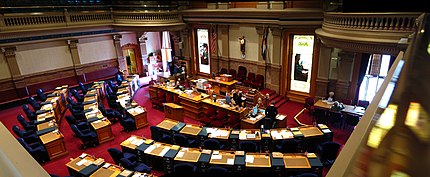Quadratic voting

Quadratic voting is a collective decision-making procedure which involves individuals allocating votes to express the degree of their preferences, rather than just the direction of their preferences.[1] By doing so, quadratic voting seeks to address issues of voting paradox and majority rule. Quadratic voting works by allowing users to "pay" for additional votes on a given matter to express their support for given issues more strongly, resulting in voting outcomes that are aligned with the highest willingness to pay outcome, rather than just the outcome preferred by the majority regardless of the intensity of individual preferences. The payment for votes may be through either artificial or real currencies (e.g. with tokens distributed equally among voting members or with real money).[2][1] Quadratic voting is a variant of cumulative voting in the class of cardinal voting. It differs from cumulative voting by altering "the cost" and "the vote" relation from linear to quadratic.
Quadratic voting is based upon market principles, where each voter is given a budget of vote credits that they have the personal decisions and delegation to spend in order to influence the outcome of a range of decisions. If a participant has a strong support for or against a specific decision, additional votes could be allocated to proportionally demonstrate the voter's support. A vote pricing rule determines the cost of additional votes, with each vote becoming increasingly more expensive. By increasing voter credit costs, this demonstrates an individual's support and interests toward the particular decision.[3] If money is used, it is eventually cycled back to the voters based upon per capita. Both E Glen Weyl[4] and Steven Lalleywhen exactly? conducted research in which they claim to demonstrate that this decision-making policy expedites efficiency as the number of voters increases. The simplified formula on how quadratic voting functions is[5]
In quadratic voting, the cost to the voter is equal to the square of the vote's weight.
References
- ↑ a b Lalley, Steven P.; Weyl, E. Glen (2018-05-01). "Quadratic Voting: How Mechanism Design Can Radicalize Democracy". AEA Papers and Proceedings. American Economic Association. 108: 33–37. doi:10.1257/pandp.20181002. ISSN 2574-0768.
- ↑ Posner, Eric A.; Weyl, E. Glen (2018). Radical markets: uprooting capitalism and democracy for a just society. ISBN 9780691177502. OCLC 1030268293.
- ↑ Posner, Eric (30 December 2014). "Quadratic voting". ERIC POSNER. Retrieved 9 October 2019.
- ↑ Weyl, E. Glen (1 July 2017). "The robustness of quadratic voting". Public Choice. 172 (1): 75–107. doi:10.1007/s11127-017-0405-4. ISSN 1573-7101. (see also Semantic Scholar id 189841584)
- ↑ Ellenberg, Jordan (16 January 2015). "Saving Democracy With Quadratic Equations". Wall Street Journal. ISSN 0099-9660. Retrieved 19 November 2019.
